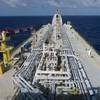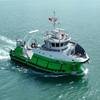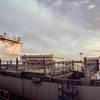Foster Named as Next Self Defense Test Ship
A dedicated test and evaluation platform alleviates scheduling difficulties of obtaining an active fleet asset and allows the project sponsor to have greater control over the installation and test schedule. Additionally, since the test ship is unmanned and remotely controlled, it allows for more realistic testing without crew safety concerns. Using the SDTS allows project sponsors to identify possible problems before the system gets to the fleet. Program managers have estimated significant cost savings when a problem is discovered and corrected during testing vice production. Since many combat systems elements are already installed aboard Paul F. Foster, a direct turnover will reduce conversion costs. The destroyer also provides an all-electric plant configuration, a sizeable superstructure to support possible future Multi-Function Radar and SPS-48E installations, and has a logistical support infrastructure in place. The ex-Decatur will continue testing operations through the end of fiscal year 2003. Following the necessary modifications, Paul F. Foster will be ready to perform its test and evaluation mission in fiscal year 2005. Source: NAVSEA News Wire










